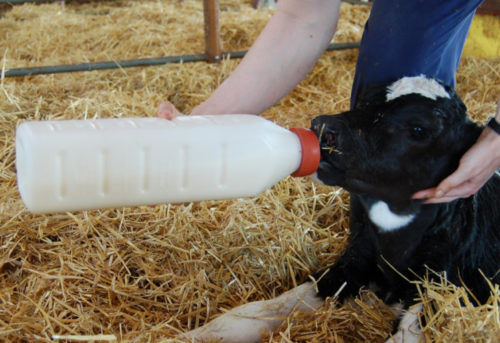Breaking 7 Common Myths on Colostrum
Posted: September 22, 2020 | Written By: Chelsea Schossow, M.S. - Form-A-Feed Nutrition and Production Specialist

First one there is the winner! It’s a race between antibodies in the colostrum and the bacteria in the environment. Who would you like to win?
I cannot even begin to count the number of times I’ve read an article or sat through a seminar about the importance of colostrum to a newborn calf. We often hear about quality, quantity, timing and the cleanliness of the colostrum. However, what’s sometimes skimmed over are the common myths associated with colostrum.
Myth 1: IgG is the only ingredient in colostrum that is beneficial. Yes, the IgGs protect the calves until they build their own immunity. However, colostrum contains multiple immune and growth compounds as well as proteins, fatty acids, vitamins, minerals and amino acids which are vital to the calf’s early digestive development.
Myth 2: Pooling colostrum from all fresh cows will improve the overall quality. The reality is that by pooling the colostrum, it makes it very easy to transmit diseases, including bovine leukemia virus and Johnes, to multiple animals instead of one or two. In addition, pooling typically over-emphasizes the poor-quality colostrum with its high volume and low concentration of antibodies.
Myth 3: The thicker the colostrum the better. The concentration of IgGs cannot be determined visually, and even if two colostrum samples of cows from the same farm look identical, their IgG concentration can vary significantly. To really tell if colostrum is of good quality it should be tested. Brix refractometer readings above 20% are considered good quality to feed to newborns to accomplish successful passive transfer when feeding a full gallon.
Myth 4: All colostrum products are alike. When a cow doesn’t produce enough colostrum, and none is stored, running to the local farm store is often the go-to solution. However, it’s important to know the difference between a colostrum replacer and a colostrum supplement. Supplements are often made from dried colostrum or serum and contain 40 to 60 grams of IgG per dose; they are used in addition to the harvested colostrum when the cow does not produce enough for the calf. It’s important to note if the harvested colostrum is low quality; even with the addition of the supplement, the calf will not have effective passive transfer. Replacers contain between 100 to 150 grams of IgG per dose, the ideal concentration for a newborn calf. Replacers are used when no colostrum is available at all for the newborn.
Myth 5: Since colostrum has so many antibodies, it’s immune to environmental bacteria. Not only is colostrum nutritious to the calf, it also sets up a great environment for bacteria to thrive in. Properly storing colostrum in clean, sanitized containers and rapidly cooling it will help prevent bacteria from feeding off the nutrients in colostrum, which will later be ingested by the calf.
Myth 6: Colostrum from first lactation cattle should be discarded. It is true that heifers typically produce less colostrum, but the quality is often acceptable. In addition, most herds generally do not have enough older cows to supply enough colostrum to feed all the calves born.
Myth 7: The quickest and best way to thaw frozen colostrum is by running it under very hot water. Yes, this may be the quickest way to get frozen colostrum ready for a calf, however, very hot water is an enemy of antibodies. Water above 145 °F will cook and destroy the antibodies the calf needs. It’s best to thaw frozen colostrum in 140°F water slowly.
At the end of the day, our main goal is to raise a healthy calf to work as a replacement into the herd. Often, we get so caught up in the bigger picture we forget about the basics. I challenge everyone to reevaluate their colostrum program and protocol and reconsider a few of these myths that have surfaced over the past decade.